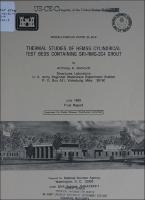Please use this identifier to cite or link to this item:
https://hdl.handle.net/11681/11109| Title: | Thermal studies of HEMSS cylindrical test beds containing SRI-RMG-2C4 grout |
| Authors: | United States. Defense Nuclear Agency Bombich, Anthony A. |
| Keywords: | Computer programs Nuclear explosions Cylinders Thermal properties Grouts Mortar Concrete Concrete temperature High-Explosive Model Structure Simulation Program |
| Publisher: | Structures Laboratory (U.S.) Engineer Research and Development Center (U.S.) |
| Series/Report no.: | Miscellaneous paper (U.S. Army Engineer Waterways Experiment Station) ; SL-82-9. |
| Description: | Miscellaneous Paper Abstract: Large cylindrical test beds 2.13 m (7 ft) in diameter and cast from SRI-RMG-2C4 grout were used by Merritt CASES Inc., and Physics International Company to investigate the simulation of nuclear structures in the "High-Explosive Model Structure Simulation (HEMSS) Program." 2C4 grout was used in the test beds and reached temperatures in excess of 108°C (226°F) in HEMSS No. 1 and 2 cylinders. Although the grout properties were well documented, the effects of heat of hydration on the grout when cast in large volumes were unknown. Thermal studies of the HEMSS cylinders were conducted at the U.S. Army Engineer Waterways Experiment Station (WES) based upon computer simulations. These studies were conducted to determine the thermal response of 2C4 grout placed in mass. The computer simulations were conducted in four groups. Group I runs were conducted to duplicate the thermal histories in the HEMSS No. 1 cylinder, including the establishment of thermal properties. Group II computer runs were made to evaluate several temperature control measures which could be employed on future HEMSS test beds to reduce internal temperature and potential excessive thermal stress or strain. Measures recommended included reducing placement temperature and ventilating the 0.3048-m (1-ft) hole at the axis of the cylinders. Group III runs predicted temperatures in the HEMSS No. 3 cylinder while evaluating the effects of the diurnal ambient temperature cycle and the several attainable placement temperatures. Group IV runs included postcasting temperature and thermal stress-strain evaluation of the 2.13-m (7-ft) diameter HEMSS No. 3 cylinder as well as the same analysis on potential 3.66- and 6 .10-m (12- and 20-ft) diameter cylinders. The study showed that the finite-element method temperature simulation program in use at WES could predict temperature distribution in the HEMSS cylinders as a function of time after casting. Temperature in the 2.13-m (7- ft) diameter cylinders could only be effectively controlled by lowering the placement temperature of the grout. Simulations of 3.66- and 6.10-m (12- and 20- ft) diameter cylinders indicated increasing peak temperature and thermal strains as cylinder diameter increased. With conditions similar to those of the HEMSS No. 3 cylinder, a 6.10-m (20-ft) diameter cylinder is predicted to reach a peak temperature of 116°C (240°F). It is recommended that additional work be done to document the properties of 2C4 grout when cured at temperatures at or near 100°C (212°F). |
| Rights: | Approved for public release; distribution is unlimited. |
| URI: | http://hdl.handle.net/11681/11109 |
| Appears in Collections: | Miscellaneous Paper |
Files in This Item:
| File | Description | Size | Format | |
|---|---|---|---|---|
| MP-SL-82-9.pdf | 8.51 MB | Adobe PDF |  View/Open |